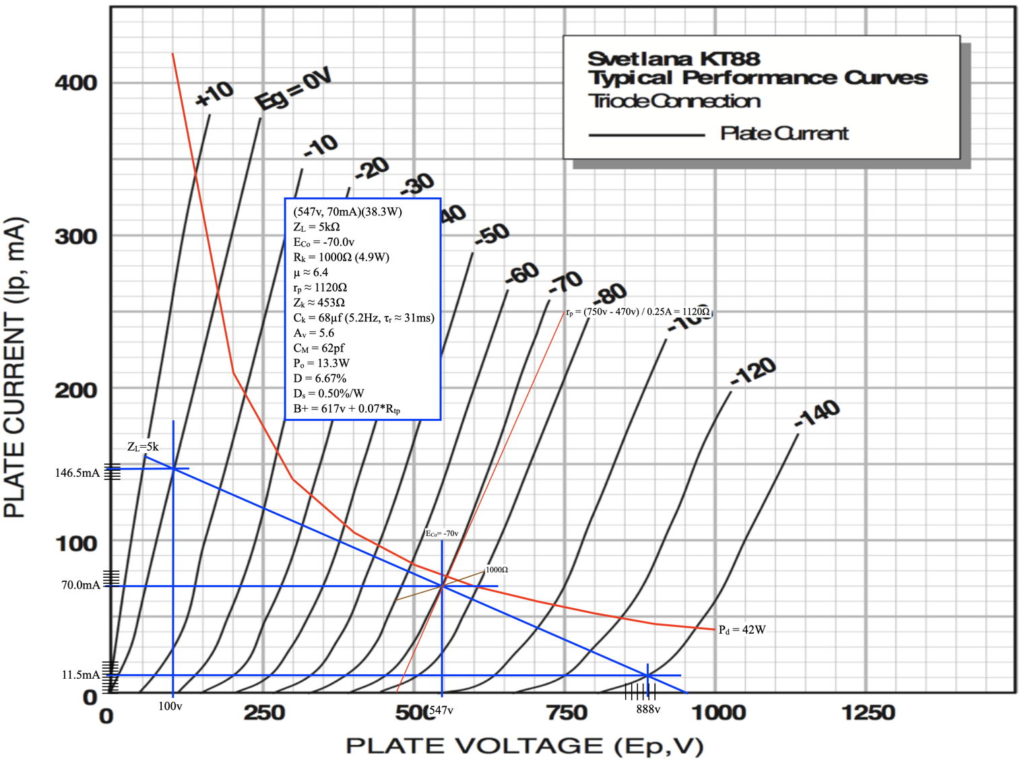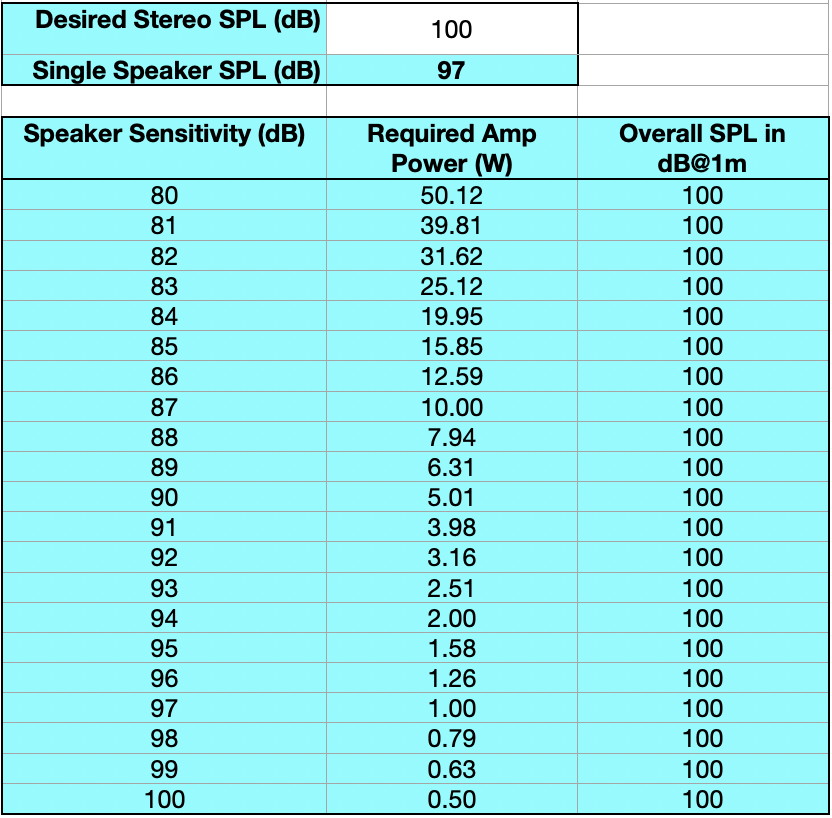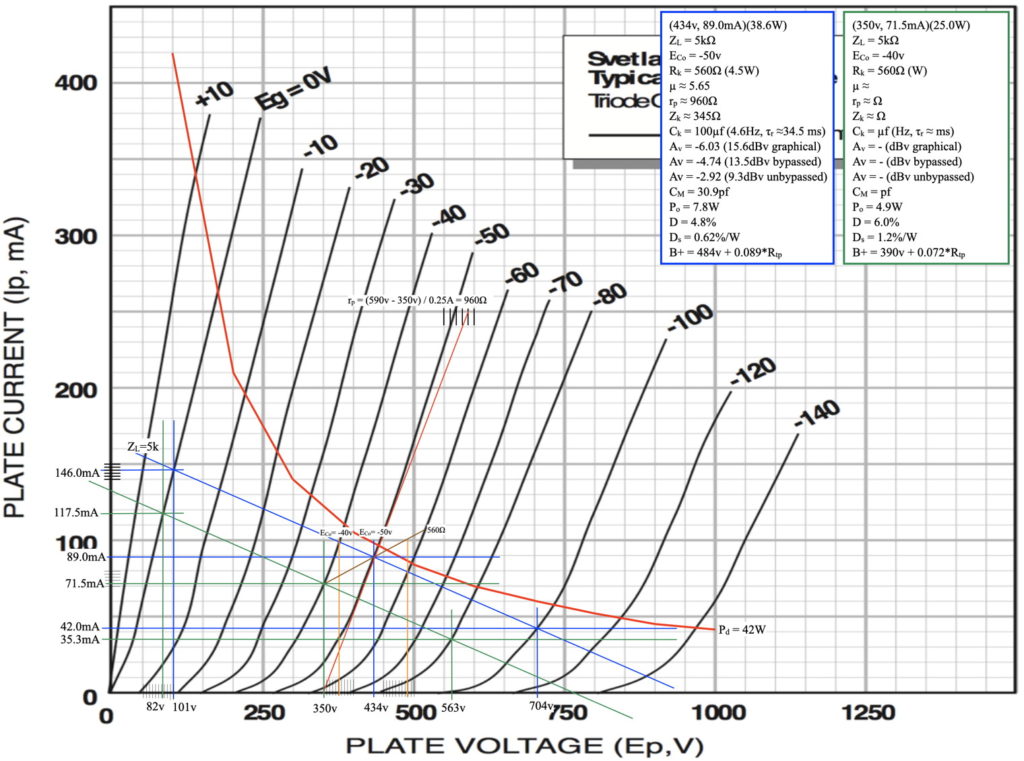With my shop temperature hovering around 38°F (≈3°C) and with the outside temperature hovering around 20°F (≈-7°C) I though that today might be a good time for a little “inside” amplifier discussion. And today’s discussion is about SETs; BIG ONEs.
SET Fundamentals and the KT88
A few days ago I was corresponding with someone who mentioned that he might like a SET with around 20W/channel output; maybe based on the KT88 or KT120 run in a triode strapped mode. As luck would have it, that same morning I was reviewing some KT88 triode strapped load line designs. And, although I have not put one together yet, the thought of running the KT88 in this mode has always intrigued me.
The KT88 (or its American brother the 6550) is a large beam power tube intended for high power audio amplifier applications. In a push-pull topology, operating in class-AB1, a pair of these big tubes can generate over 100W of output power. It has power dissipation ratings of 35W for the plate and 6W for the screen or a combined 40W when operated in triode mode. With a plate voltage limit of 600V it should be possible to get ample power out of this big tube.
Now the theory says that the optimum output power of a triode stage (operating in class A1) is proportional to the quiescent plate voltage (Ebo) squared and inversely proportional to the plate resistance (rp). So, to get the best power output requires two things.
First, is to make rp as low as possible. To accomplish this, a quiescent operating point is selected in a region of the plate characteristics where the curves of constant grid voltage have large slope. Since the plate resistance is inversely proportional to the slope of these contours, the “steeper” the grid voltage curve on the plate characteristics diagram, the lower the effective plate resistance at that operating point.
Second is to maximize (within reason) the plate voltage at the operation point. Because the optimum output power is proportional the plate voltage squared, a 41% higher plate voltage generates twice the output power. Clearly, for the KT88, the plate voltage should be as close to that 600v maximum as possible.
So, using these two principles a load line design was developed for the KT-88 in triode strapped mode. Here is the information.
This stage doesn’t meet the 20W/channel my correspondent was discussing, but it does get to 13.3W which is only about 1.8dB shy (11.2 dBW verses 13dBW). This difference in output power is fairly inconsequential. Also the full scale distortion is only 6.67% or 0.5%/Watt. The relatively low plate resistance (≈1.1kΩ) should support excellent low frequency production as well. In short, this output stage should sound fantastic.
However, there is something else about this output stage that should be noted; the B+ voltage. Since I wanted to maintain the typical SET tones, I opted for cathode bias instead of fixed bias. This pushes the required B+ to about 630V. The problems with this level of B+ voltage include expensive power supply components, risk of high frequency corona significantly raising the noise floor of the amplifier, and layout issues. Using fixed bias would reduce the B+ required to about 560V (at the cost of some tonal quality) but even this is high enough to cause the same issues. None of these problems are insurmountable, but they do add significant cost and complexity.
So the real question to be answered is this: Is the power output worth the issues in building the amp? Let’s discuss this.
SET Characteristics and Why We Build Them
The real reason that SETs are so popular is due to their unique tonal characteristics. These include rich levels of 2nd and 4th order even harmonics, by consequence a lack of off-tone intermodulation products, and very balanced tonal characteristics across the bandpass spectrum. So the SET sound is all about relative types of distortions (or as I call them “color”) and the overall tone.
There is another thing which is necessary to understand about audio quality and it’s this. Once the Sound Pressure Level (SPL) at the opening of the ear canal exceeds about 100dB (or about 2Pa) it becomes very difficult (if not impossible) to actually perceive these tonal characteristics. This is simply due to the structure of the human cochlea and the way it functions. So, how loud is “100dB”? Here are some examples: a circular saw operating in your hand ≈95dB, a nightclub standing 1m from a speaker ≈100dB, a chainsaw at 1m ≈105dB. These are all relatively loud. In fact, NIOSH (National Institute for Occupational Safety and Health, a division of the US Centers for Disease Control {CDC}) sets the maximum permissible exposure time at 100dB to no more than 15 minutes in any 24 hour period. Beyond this limit hearing damage (including TTS & PTS) can result.
Let’s examine what would happen if 100dB SPL is chosen as the maximum volume required for our SET. If the requirement is much louder a more efficient push-pull topology would be more appropriate. At high volumes, most amps (except for the very bad) all tend to sound very similar. And before the internet comes with torches and pitchforks in hand to haul me away, this is true due to basic human physiology. It is not an attack on any individual or their hearing.
Public Service Announcement: If you believe that you can detect minor tonal differences at 110 dB SPL, please have your physician send the details of your super-evolved hearing organs so that the world can know that there are super humans among us. 😉
Getting back to that 100dB SPL, obviously there is more to the resultant SPL than the amp output. The speaker sensitivity also plays an important role. So what I did to illustrate this is wrote a simple spreadsheet which shows required amp power for a given SPL against speaker sensitivity. Here is that table.
You’ll notice that this table assumes that two channels will be used. As such, the power numbers are based on 97dB as opposed to 100dB; the 3dB accounting for the combined power of two channels.
At the low end of speaker sensitivity (80dB SPL per 1W at 1m) it takes some impressive power numbers to reach the 100dB SPL (≈50W). A point of interest; during the “Stereo Wars” of the 1970s, there were multiple models of speakers with sensitivities this low. But the really interesting thing about this table is how fast the power requirements drop (logarithmically actually) as the speaker sensitivities rise.
Referring back to my correspondent’s 20W/channel requirement, the table indicates that this power is only required if the speaker sensitivity is only ≈84dB. Using my load line design (13.3W), the table indicates an 86dB speaker sensitivity is needed to meet the requirement. However, today speaker sensitivities in the 90dB to 100dB range are rather common. The table shows that at 90dB sensitivity only about 5 watts are required and, if the speaker is 94dB only a measly two watts are required. This should be enlightening.
Setting Requirements
The question posed above was “Is the power output worth the issues in building the amp?”. The answer, like most Engineering problems, is “It depends”. If you are forced to used low efficiency speakers then maybe a lot of output power really is required. However, I would posit that 1.) because higher efficiency speakers are commonly available and, 2.) because the added expensive of the high power SET could easily furnish the funds for the higher efficiency speakers, that one should strive for lower amplifier powers and higher speaker efficiency. This then becomes a system trade between amplifier and speakers with cost as an independent variable.
Let’s revisit the KT88 SET but under the assumptions that 100dB SPL is the maximum requirement and that we have speakers with a 90dB sensitivity.
Alternative KT88 SET Designs
So what drives the cost in the example above is the high B+ voltage and the complexities it brings. However, if the B+ can be reduced to say under 500v, then the cost and complexity of the power supply becomes much less. Here are the load line designs for two additional KT88 based SETs but with significantly lower B+ voltages.
In this example I have again chosen cathode bias but at lower bias voltages of -50v or -40v using a 560Ω biasing resistance. The results are interesting. From the SPL table above, about 5W is required to meet the volume requirement for 90dB sensitivity speakers. The higher power example with a B+ of ≈500V easily meets power output requirements with 7.8W power delivery and distortion at 4.8% (0.62%/W). What’s even more interesting however, is that when the B+ is lowered to ≈400v for the lower power example it still delivers almost 5W with distortion at 6% (or 1.2%/W). So in reality either of these examples essentially meets the SPL requirement (which is still fairly loud) without the much higher B+ power and the complexities it drives. And because the design performs well at both these B+ voltage levels, there is much less criticality in setting the B+ requirement.
Conclusion
I believe it has been established that neither of the 20W/channel or the 13.3W/channel designs initially explored is truly required for a SET. This is based on the tonal qualities desired from SETs and the conditions under which those qualities can be appreciated. Using good sensitivity speakers (e.g. 90dB to 94dB) much less power is required to achieve the SPL requirement. Functionally a power level between 2w and 5W.
To be fair, there are two little “sleight of hand” tricks I’ve used in these arguments but they work against each other. The first is that you are likely to lose about a dB in output transformer efficiency so amp power numbers or speaker efficiency numbers should, strictly speaking, be about a dB higher. However, the choice of the 100dB SPL is actually highly conservative. Most people really don’t appreciate how loud 100dB is in actually listen environments. The requirement could easily be set a full 5dB lower and most listeners would never even notice the difference.
I am still intrigued by this idea of a triode strapped KT88. And now that I know I don’t need to push the big tube for all it’s worth, a design for an amp is solidifying in my mind. But more thought is required.




Pingback: The Next Amp | Cascade Tubes
Matt this is extremely interesting as I’m playing with PL36 tubes which are producing very few power but I noticed as well that it’s ok, depends on the music you are listening. If you want Pink Floyd to wake up your neighbors, you’d need some more real watts, but who wants to be making their neighbors angry, besides Georges@Tubelab 🙂
Below a list of URLs about Loudspeaker Power Handling / SPL / amp wattage I collected over time. Some good reading.
NOTE: Links may be found on Blog Page Sidebar under “Articles of Note” – Admin
I’m curious. When you did the UL work on the 6L6 did you ever create a baseline with no feedback (like a triode strapped tube) for comparison?
I have looked at the 6L6 triode strapped but found the project uninteresting. I have a design giving about 4.8W at a B+ of ≈480V with good distortion characteristics, but never really pursued it. Now, with a 6L6 UL design that puts out over 7W with really good distortion characteristics from the optimization activity, running the 6L6 triode strapped seem unwarranted.
I have an 807 triode strapped design putting out about 4.3W per channel that I really want to build. Just because I like the large tubes and like the way it sounds. This will probably be my next triode strapped pentode design when I finally get around to it.
It makes that you would be giving up way more than you are getting back with a triode strapped 6L6 design.
It is interesting that your 400V number is similar to the B+ of Alex Gendrano’s KT88 DIY project with a UL/Triode switch.
Actually, an 807 in reality is a repackaged 6L6. So a triode strapped 6L6 would probably perform and sound about the same.
While we are on the subject, have you given any consideration to running in straight pentode mode? Maybe with a little global NFB to clean things up a bit.
I have been hearing the “807 is just a 6L6” assertion for over a decade. It’s simply not true. I have used both tubes extensively and they are nowhere near the same. Just try overlaying the plate characteristics; very different. I think this was a marketing ploy by some company making the ubiquitous socket adaptors so guitar players could plug an 807 into a 6L6 socket in their amps. Sound still comes out of the amp, but that’s where the similarities end.
As for running things in pentode mode: I hate pentode mode. That mode sounds way too transistor like for my tastes. Way too much higher harmonic distortions.
Of interest, after a lot of reading over the years, about 80 dB SPL is required to simulate “live levels” in the average home.
Personal experience seems to bear this out.
90 dB and I can’t hear myself think.
100 dB makes my head feel like it wants to explode.
Home audio does NOT need anywhere as much power as the “marketing people” are trying to lead the public to believe.
My ears and my sound meter agree with your assessment. Listening at at 100dB SPL is courting serious hearing damage; and it’s not “high fidelity”.
As a test, I just took out my hand help power meter and turned the amp in my office to what I thought was a reasonable “dedicated” listening volume. This was louder than average conversation level and with enough presence to cover any leakage noise creeping into the office from other parts of the house. Surprise of surprises, the A-weighted, fast response average was about 60dB SPL with peaks running to about 70dB SPL. When I pushed the volume to 80dB ave / 90dB peak, the music volume was almost too loud for comfortable listening. And this was with the little 1.3W/channel 6CY7 Zebrawood amp and about 89dB sensitivity speakers.
Doing a quick test: In my living room, 60 dB is a room filling comfortably loud level. Drowns out all external noise, but is easy on the ears. Pushing much beyond that would, in my opinion start to get too loud for comfort.